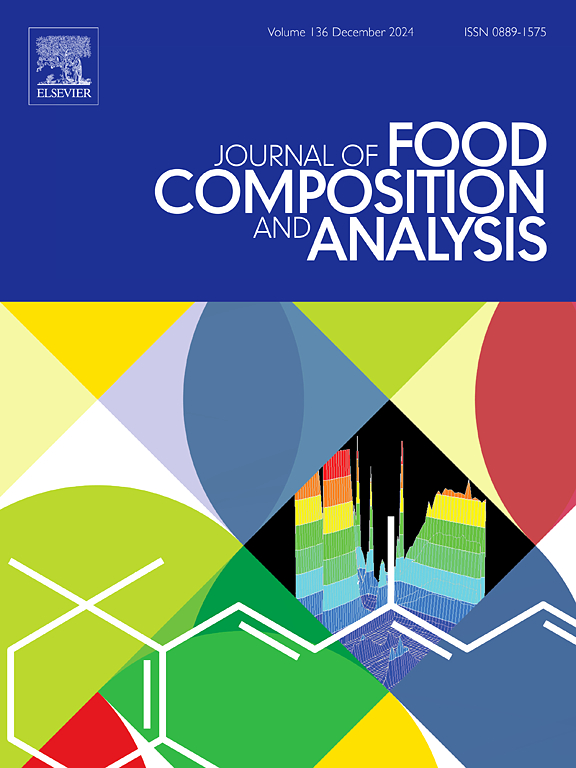Health risk due to the presence of trace elements in stingless bee honey consumed in the Amazon and Southern Brazil
IF 4.6
2区 农林科学
Q2 CHEMISTRY, APPLIED
引用次数: 0
Abstract
The presence of some essential and non-essential trace elements in stingless bee honeys raises public health concerns, even though research evaluating these honeys is scarce. A comparison was made of the concentrations of 11 potentially toxic trace elements in honey samples from five stingless bee species collected in two states in Brazil. Trace elements were quantified by ICP-OES. The average concentrations (mg.kg−1) of trace elements were: Al (1.728), Mn (1.301), Zn (1.071), Cu (0.471), Sn (0.372), Sr (0.366), Ba (0.299), Sb (0.245), Ni (0.047), Co (0.013) and Cd (0.008). The results indicated that honey from Paraná (South region) contained higher levels of Ba and Co, while honey from Rondônia (Amazon region,) had the highest concentration of Sb. The variation in the results may not be related to the bee species’ behaviors, but rather to their foraging territory to collect nectar/pollen and the type of plants and flowers visited. This observation allows considering honey as a good indicator for monitoring environmental contaminants. The results of the health risk assessment based on the consumption of the honey samples collected in the two evaluated states did not indicate carcinogenic risk due to lifetime consumption of the products.
由于在亚马逊和巴西南部消费的无刺蜜蜂蜂蜜中存在微量元素造成的健康风险
无刺蜜蜂蜂蜜中一些必需和非必需微量元素的存在引起了公众对健康的关注,尽管评估这些蜂蜜的研究很少。对巴西两个州采集的五种无刺蜜蜂蜂蜜样品中11种潜在有毒微量元素的浓度进行了比较。用ICP-OES测定微量元素含量。微量元素平均浓度(mg.kg−1)为:Al(1.728)、Mn(1.301)、Zn(1.071)、Cu(0.471)、Sn(0.372)、Sr(0.366)、Ba(0.299)、Sb(0.245)、Ni(0.047)、Co(0.013)、Cd(0.008)。结果表明,来自南方地区paranar 的蜂蜜Ba和Co含量较高,而来自亚马逊地区Rondônia的蜂蜜Sb含量最高。结果的差异可能与蜜蜂种类的行为无关,而与它们采集花蜜/花粉的范围以及所访问的植物和花朵类型有关。这一观察结果允许考虑蜂蜜作为监测环境污染物的良好指标。基于在两个被评估州收集的蜂蜜样本的消费的健康风险评估结果没有表明由于终生食用这些产品而存在致癌风险。
本文章由计算机程序翻译,如有差异,请以英文原文为准。
求助全文
约1分钟内获得全文
求助全文
来源期刊

Journal of Food Composition and Analysis
工程技术-食品科技
CiteScore
6.20
自引率
11.60%
发文量
601
审稿时长
53 days
期刊介绍:
The Journal of Food Composition and Analysis publishes manuscripts on scientific aspects of data on the chemical composition of human foods, with particular emphasis on actual data on composition of foods; analytical methods; studies on the manipulation, storage, distribution and use of food composition data; and studies on the statistics, use and distribution of such data and data systems. The Journal''s basis is nutrient composition, with increasing emphasis on bioactive non-nutrient and anti-nutrient components. Papers must provide sufficient description of the food samples, analytical methods, quality control procedures and statistical treatments of the data to permit the end users of the food composition data to evaluate the appropriateness of such data in their projects.
The Journal does not publish papers on: microbiological compounds; sensory quality; aromatics/volatiles in food and wine; essential oils; organoleptic characteristics of food; physical properties; or clinical papers and pharmacology-related papers.
 求助内容:
求助内容: 应助结果提醒方式:
应助结果提醒方式:


